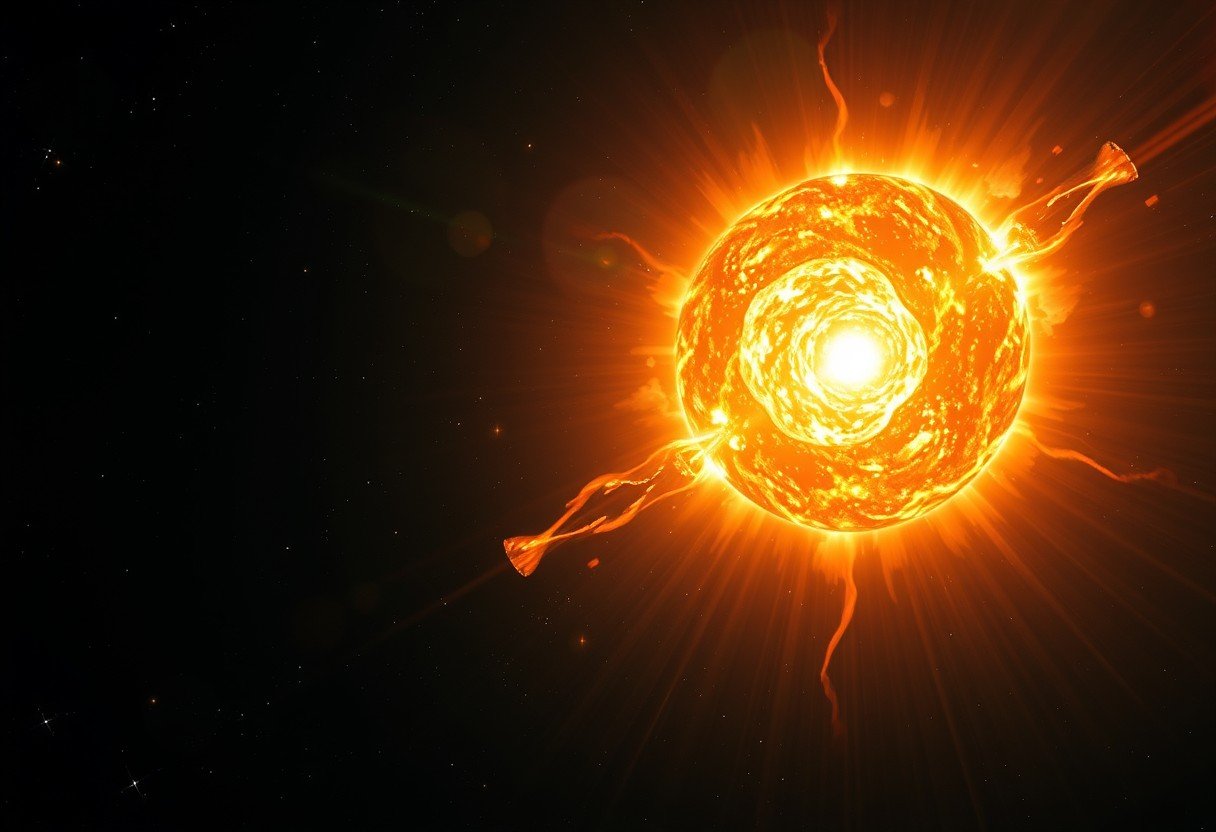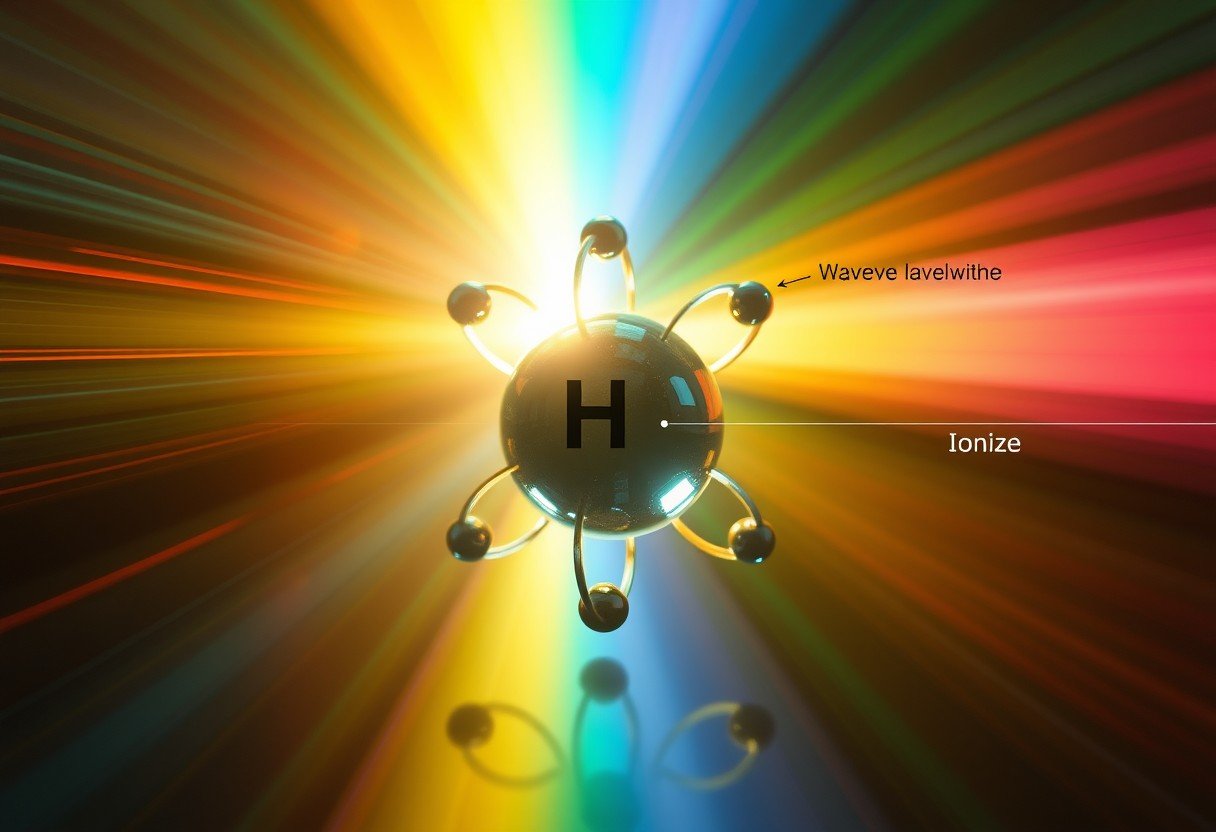Stars are not just beautiful lights in the night sky; they are massive celestial engines powered by incredible forces. For billions of years, stars maintain a delicate balance between collapsing under their own immense gravity and exploding from their internal energy. This stability comes from two primary processes that generate the energy needed to create outward thermal pressure: nuclear fusion and gravitational contraction. Understanding how these two forces work is key to unlocking the secrets of a star’s life.
What is Nuclear Fusion and How Does it Power a Star?
Nuclear fusion is the main engine of a star, responsible for the light and heat it radiates into space. This process takes place deep within the star’s core, where temperatures and pressures are unimaginably high.
In the simplest terms, nuclear fusion is the process of combining lighter atomic nuclei to form a heavier nucleus. For most of a star’s life, this involves hydrogen nuclei (protons) smashing together to create helium nuclei. This transformation is not a simple merge; it releases a tremendous amount of energy in the process.
This released energy travels from the core to the star’s surface, creating an outward push known as thermal pressure. This pressure perfectly counteracts the inward pull of gravity, allowing the star to remain stable for millions or even billions of years in a state called hydrostatic equilibrium.
The Crucial Role of Gravitational Contraction
Before a star can even begin fusion, another process must take over: gravitational contraction. This is the fundamental force that births a star from a vast cloud of gas and dust, known as a nebula.
Gravity pulls this material together, causing the cloud to shrink and become denser. As the particles get squeezed closer, they collide more frequently, which generates a massive amount of heat. This rise in temperature from gravitational contraction is what eventually ignites nuclear fusion in the core.
Gravitational contraction doesn’t just happen at the beginning of a star’s life. It also plays a critical role when a star runs out of its primary nuclear fuel. As fusion slows down, gravity takes over again, causing the core to contract and heat up, which can sometimes trigger the fusion of heavier elements.
Fusion vs. Contraction: A Tale of Two Energy Sources
While both nuclear fusion and gravitational contraction generate heat, they operate in very different ways and dominate different stages of a star’s life. Fusion is a long-term, sustainable power source, while contraction is more of a transitional energy generator.
The energy output from fusion is vastly superior to that of gravitational contraction. A tiny amount of mass converted into energy through fusion releases an explosive amount of power, as described by Einstein’s famous equation, E=mc². This is why stars can shine so brightly for such long periods.
| Feature | Nuclear Fusion | Gravitational Contraction |
|---|---|---|
| Primary Mechanism | Combining light atomic nuclei into heavier ones. | Compression of matter due to the inward pull of gravity. |
| Energy Output | Extremely high and sustained over long periods. | Lower and typically occurs over shorter, transitional phases. |
| Dominant Life Stage | Main sequence (the longest phase of a star’s life). | Star formation (protostar stage) and late-stage evolution. |
How These Processes Shape a Star’s Life
The entire life cycle of a star is a story told by the battle between fusion and gravity. The journey begins with gravitational contraction heating a protostar until its core is hot enough for fusion to begin. This marks the star’s birth and its entry into the main sequence phase.
A star spends about 90% of its life on the main sequence, steadily fusing hydrogen into helium. Once the hydrogen fuel in the core is depleted, the balance is broken. Gravity causes the core to contract again, increasing the temperature until helium can start fusing into carbon. This new phase transforms the star into a red giant.
The star’s ultimate fate depends entirely on its initial mass, which dictates which elements it can fuse and how it will end its life, whether as a quiet white dwarf or in a spectacular supernova explosion.
Does a Star’s Size Change How it Makes Energy?
A star’s mass is the single most important factor determining how it generates energy and how long it will live. The processes inside a small, dim star are vastly different from those in a massive, bright one.
The differences can be broken down into two main categories:
- Low-Mass Stars: Stars like our Sun, or smaller, burn their hydrogen fuel very slowly. They maintain a stable equilibrium for billions of years. When they run out of hydrogen, they will fuse helium but typically cannot create heavier elements. Their lives end gently, leaving behind a compact core called a white dwarf.
- High-Mass Stars: These stars are at least eight times more massive than our Sun. Their immense gravity creates much higher core temperatures and pressures, causing them to burn through their fuel at a furious rate. They live short, dramatic lives, fusing progressively heavier elements until they reach iron.
Because iron fusion does not release energy, the core collapses catastrophically, triggering a supernova explosion. This violent event blasts heavy elements across the galaxy, providing the raw materials for new stars, planets, and even life.
Frequently Asked Questions
What are the two main ways a star produces energy?
A star’s two main energy-generating processes are nuclear fusion, where atomic nuclei are combined in the core, and gravitational contraction, where the star’s own gravity squeezes its material to produce heat.
Why is nuclear fusion so important for a star’s stability?
Nuclear fusion releases an enormous amount of energy, creating outward thermal pressure. This pressure pushes against the inward pull of gravity, establishing a balance called hydrostatic equilibrium that keeps the star stable for most of its life.
When does gravitational contraction generate energy for a star?
Gravitational contraction is most important during a star’s formation, when it heats a cloud of gas and dust until fusion can begin. It also becomes a key energy source in a star’s later stages when it runs out of fuel, causing the core to collapse and heat up.
Do bigger stars make energy differently than smaller stars?
Yes, mass dramatically changes energy generation. High-mass stars burn fuel much faster and at higher temperatures, allowing them to fuse heavier elements up to iron. Low-mass stars fuse only lighter elements like hydrogen and helium and have much longer lifespans.
What happens when a star runs out of fuel for fusion?
When a star exhausts its core fuel, the outward pressure from fusion stops. Gravity takes over, causing the core to contract and heat up. This can either ignite the fusion of a new, heavier element or, if the star is not massive enough, lead to its final form as a white dwarf, neutron star, or black hole.









Leave a Comment